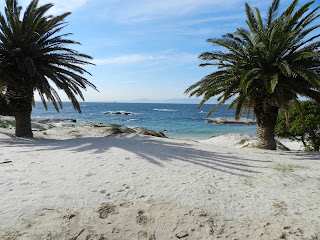Apartheid Museum
Apartheid Museum
We visited the Apartheid
Museum at the end of our last day in Johannesburg, which was a powerful display
of South Africa’s history.
The museum opens with an
explanation of the history of South Africa’s colonization first by the Dutch
and then by the British. There was a lot for us to learn about the dynamics of
these two European countries and their lasting legacies on South Africa.
Our tour guide Pieter gave us
a shortened history of the two countries and the creation of Apartheid. He told
us that there were two major wars fought between them called the Anglo-Boer
Wars, the first lasting 3 months, and the second lasting 3 years. After the
second war the British took over control of South Africa, however, the
Afrikaaners (Dutch descendants) established a strong nationality that continued
to build and grow. In 1948 the
Afrikaaners won the majority in the government with their party called the
National Party and passed laws that made the discrimination of the black
African population legal. These laws and regulations are known as Apartheid. In
Afrikaans “apartheid” means separateness.
Then the museum went into
detail about the affect of the Apartheid laws on the black South African people. When we received our tickets to the museum some
of the tickets read “Nie-Blankes” (Non Whites) and some had “Blankes” (Whites)
written on them. Depending on the ticket you were given you had to go through a
door marked with that label. It was an effective way for us to enter the museum
because it got us all in the mindset of separation simply by the color of our
skin.
There is a whole section of
the museum dedicated to Nelson Mandela, which includes running video clips of
him being interviewed, as well as many pictures and displays of letters that he
wrote and many other details about his role in the dismantling of
Apartheid. This part of the museum I
found especially moving, as I have always loved learning about Mandela and the
incredible way he changed his country.
There are numerous powerful quotes
on all of the walls in this section of the museum. The quotes are color-coded
based on the content of his quote, for example, leadership might be green while
courage is blue. As you read and reflect
on the content of the quotes, individuals are encouraged to identify the theme
of the messages that appeals to them and pick the one color that resonates the
most with them. Off to the side are bins that contain small polls that match
the various colors that correspond to the quotations. Once you select a pole
you are meant to place it in a display with those that have been selected by
other visitors. I found this activity moving because the bins were
multi-colored, and very few of the people I asked picked the same color that I
did. This was a great demonstration of the power of Nelson Mandela’s words and
how they resonate differently for all of us.






Comments
Post a Comment